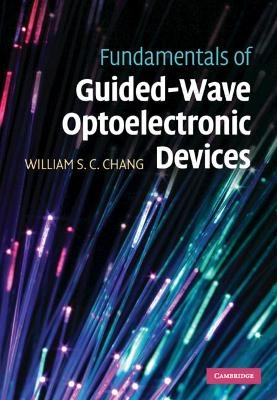
Fundamentals of Guided-Wave Optoelectronic Devices
Seiten
2009
Cambridge University Press (Verlag)
978-0-521-86823-5 (ISBN)
Cambridge University Press (Verlag)
978-0-521-86823-5 (ISBN)
Uniquely combining the optical and electrical properties of guided-wave optoelectronic devices, this book provides the key concepts and techniques for readers to apply to current and future devices. It presents the impact of material properties on guided-wave devices, and emphasizes the importance of time-dependent interactions between electrical and optical signals.
Optoelectronic guided-wave devices are used in a wide range of optical fiber communication and optoelectronic systems. In such networks, the electrical and the optical characteristics of guided-wave devices, and the interplay between them, have a profound effect on system design and overall performance. Uniquely, this book combines both the optical and electrical behavior of guided-wave optoelectronic devices so that the interwoven properties, including interconnections to external components, are easily understood. It provides the key concepts and analytical techniques that readers can apply to current and future devices. It also presents the impact of material properties on guided-wave devices, and emphasizes the importance of time-dependent interactions between electrical and optical signals. This is an ideal reference for graduate students and researchers in electrical engineering and applied physics departments, as well as practitioners in the optoelectronics industry.
Optoelectronic guided-wave devices are used in a wide range of optical fiber communication and optoelectronic systems. In such networks, the electrical and the optical characteristics of guided-wave devices, and the interplay between them, have a profound effect on system design and overall performance. Uniquely, this book combines both the optical and electrical behavior of guided-wave optoelectronic devices so that the interwoven properties, including interconnections to external components, are easily understood. It provides the key concepts and analytical techniques that readers can apply to current and future devices. It also presents the impact of material properties on guided-wave devices, and emphasizes the importance of time-dependent interactions between electrical and optical signals. This is an ideal reference for graduate students and researchers in electrical engineering and applied physics departments, as well as practitioners in the optoelectronics industry.
William S. C. Chang is an Emeritus Professor of the Department of Electrical and Computer Engineeering, University of California, San Diego. After receiving his Ph.D. from Brown University in 1957, he pioneered maser and laser research at Stanford University, and he has been involved in guided-wave research since 1971. He has published over 200 technical papers and books, including Principles of Lasers and Optics (Cambridge, 2005) and RF Photonic Technology in Optical Fiber Links (Cambridge, 2002).
1. The formation and analysis of optical waveguides; 2. Guided wave interactions; 3. Electrooptical effects; 4. Time dependence, bandwidth and electrical circuits; 5. Planar waveguide devices; 6. Channel waveguide components.
| Erscheint lt. Verlag | 1.10.2009 |
|---|---|
| Verlagsort | Cambridge |
| Sprache | englisch |
| Maße | 180 x 253 mm |
| Gewicht | 580 g |
| Themenwelt | Naturwissenschaften ► Physik / Astronomie ► Optik |
| Technik ► Elektrotechnik / Energietechnik | |
| ISBN-10 | 0-521-86823-8 / 0521868238 |
| ISBN-13 | 978-0-521-86823-5 / 9780521868235 |
| Zustand | Neuware |
| Haben Sie eine Frage zum Produkt? |
Mehr entdecken
aus dem Bereich
aus dem Bereich
Grundlagen - Verfahren - Anwendungen - Beispiele
Buch | Hardcover (2022)
Hanser, Carl (Verlag)
CHF 69,95
Grundlagen und Anwendungen
Buch | Hardcover (2023)
Hanser, Carl (Verlag)
CHF 83,95


